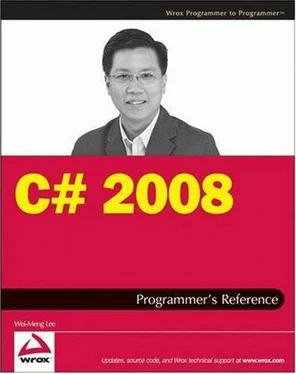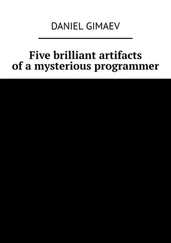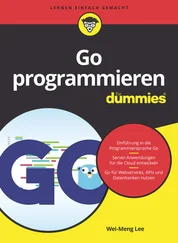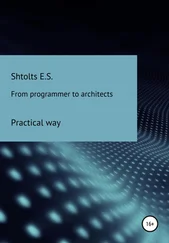Wei-Meng Lee - C# 2008 Programmer's Reference
Здесь есть возможность читать онлайн «Wei-Meng Lee - C# 2008 Programmer's Reference» весь текст электронной книги совершенно бесплатно (целиком полную версию без сокращений). В некоторых случаях можно слушать аудио, скачать через торрент в формате fb2 и присутствует краткое содержание. Город: Indianapolis, Год выпуска: 2009, ISBN: 2009, Издательство: Wiley Publishing, Inc., Жанр: Программирование, на английском языке. Описание произведения, (предисловие) а так же отзывы посетителей доступны на портале библиотеки ЛибКат.
- Название:C# 2008 Programmer's Reference
- Автор:
- Издательство:Wiley Publishing, Inc.
- Жанр:
- Год:2009
- Город:Indianapolis
- ISBN:978-0-470-28581-7
- Рейтинг книги:4 / 5. Голосов: 1
-
Избранное:Добавить в избранное
- Отзывы:
-
Ваша оценка:
- 80
- 1
- 2
- 3
- 4
- 5
C# 2008 Programmer's Reference: краткое содержание, описание и аннотация
Предлагаем к чтению аннотацию, описание, краткое содержание или предисловие (зависит от того, что написал сам автор книги «C# 2008 Programmer's Reference»). Если вы не нашли необходимую информацию о книге — напишите в комментариях, мы постараемся отыскать её.
C# 2008 Programmer's Reference — читать онлайн бесплатно полную книгу (весь текст) целиком
Ниже представлен текст книги, разбитый по страницам. Система сохранения места последней прочитанной страницы, позволяет с удобством читать онлайн бесплатно книгу «C# 2008 Programmer's Reference», без необходимости каждый раз заново искать на чём Вы остановились. Поставьте закладку, и сможете в любой момент перейти на страницу, на которой закончили чтение.
Интервал:
Закладка:
Code examples nearly always look like this.
Gray highlighting is used to show where new code is added to existing code, or to point out a specific section of code that's being explained in the text.
As you work through the examples in this book, you may choose either to type in all the code manually or to use the source code files that accompany the book. All of the source code used in this book is available for download at www.wrox.com. Once at the site, simply locate the book's title (either by using the Search box or by using one of the title lists), and click the Download Code link on the book's detail page to obtain all the source code for the book.
Because many books have similar titles, you may find it easiest to search by ISBN; this book's ISBN is 978-0-470-28581-7.
Once you download the code, just decompress it with your favorite compression tool. Alternatively, you can go to the main Wrox code download page at www.wrox.com/dynamic/books/download.aspx to see the code available for this book and all other Wrox books.
Every effort is made to ensure that there are no errors in the text or in the code. However, no one is perfect, and mistakes do occur. If you find an error such as a spelling mistake or faulty piece of code in one of our books, we would be grateful for your feedback. By sending in errata, you may save another reader hours of frustration, and at the same time you will be helping us provide even higher-quality information.
To find the errata page for this book, go to www.wrox.com and locate the title using the Search box or one of the title lists. Then, on the book details page, click the Book Errata link. On this page, you can view all errata that has been submitted for this book and posted by Wrox editors. A complete book list including links to each book's errata is also available at www.wrox.com/misc-pages/booklist.shtml.
If you don't spot "your" error on the Book Errata page, go to www.wrox.com/contact/techsupport.shtml, and complete the form there to send us the error you have found. We'll check the information and, if appropriate, post a message to the book's errata page and fix the problem in subsequent editions of the book.
For author and peer discussion, join the P2P forums at p2p.wrox.com. The forums are a web-based system for you to post messages relating to Wrox books and related technologies and interact with other readers and technology users. The forums offer a subscription feature to email you topics of interest of your choosing when new posts are made to the forums. Wrox authors, editors, other industry experts, and your fellow readers are present on these forums.
At http://p2p.wrox.com, you will find a number of different forums that will help you not only as you read this book but also as you develop your own applications. To join the forums, just follow these steps:
1. Go to p2p.wrox.com, and click the Register link.
2. Read the terms of use, and click Agree.
3. Complete the required information to join as well as any optional information you wish to provide, and click Submit.
4. You will receive an email with information describing how to verify your account and complete the joining process.
You can read messages in the forums without joining P2P but to post your own messages, you must join.
Once you join, you can post new messages and respond to messages other users post. You can read messages at any time on the web. If you would like to have new messages from a particular forum emailed to you, click the Subscribe to this Forum icon by the forum name in the forum listing.
For more information about how to use the Wrox P2P, be sure to read the P2P FAQs for answers to questions about how the forum software works as well as many common questions specific to P2P and Wrox books. To read the FAQs, click the FAQ link on any P2P page.
Part I
C# Fundamentals
Chapter 1
The .NET Framework
The .NET Framework is a development framework created by Microsoft to enable developers to build applications that run on Microsoft (and other) platforms. Understanding the basics of the .NET Framework is essential because a large part of C# development revolves around using the classes in that framework.
This chapter explains the key components in the .NET Framework as well as the role played by each of the components. In addition, it examines the relationships among the various versions of the Framework, from version 1.0 to the latest 3.5.
What's the .NET Framework?
The .NET Framework has two components:
□ Common Language Runtime
□ .NET Framework class library
The Common Language Runtime (CLR) is the agent that manages your .NET applications at execution time. It provides core services such as memory, thread, and resource management. Applications that run on top of the CLR are known as managed code; all others are known as unmanaged code.
The .NET Framework class library is a comprehensive set of reusable classes that provides all the functionalities your application needs. This library enables you to develop applications ranging from desktop Windows applications to ASP.NET web applications, and Windows Mobile applications that run on Pocket PCs.
Common Language Runtime
The Common Language Runtime (CLR) is the virtual machine in the .NET Framework. It sits on top of the Windows operating system (Windows XP, Windows Vista, Windows Server 2008, and so on). A .NET application is compiled into a bytecode format known as MSIL (Microsoft Intermediate Language). During execution, the CLR JIT ( just-in-time) compiles the bytecode into the processor's native code and executes the application. Alternatively, MSIL code can be precompiled into native code so that JIT compiling is no longer needed; that speeds up the execution time of your application.
The CLR also provides the following services:
□ Memory management/garbage collection
□ Thread management
□ Exception handling
□ Security
.NET developers write applications using a .NET language such as C#, VB.NET, or C++. The MSIL bytecode allows .NET applications to be portable (at least theoretically) to other platforms because the application is compiled to native code only during runtime.
At the time of writing, Microsoft's implementation of the .NET Framework runs only on Windows operating systems. However, there is an open-source implementation of the .NET Framework, called "Mono," that runs on Mac and Linux.
Figure 1-1 shows the relationships between the CLR, unmanaged and managed code.
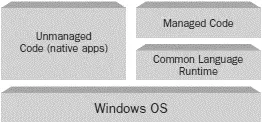
Figure 1-1
.NET Framework Class Library
The .NET Framework class library contains classes that allow you to develop the following types of applications:
□ Console applications
□ Windows applications
□ Windows services
□ ASP.NET Web applications
□ Web Services
□ Windows Communication Foundation (WCF) applications
□ Windows Presentation Foundation (WPF) applications
□ Windows Workflow Foundation (WF) applications
The library's classes are organized using a hierarchy of namespaces. For example, all the classes for performing I/O operations are located in the System.IOnamespace, and classes that manipulate regular expressions are located in the System.Text.RegularExpressionsnamespace.
Интервал:
Закладка:
Похожие книги на «C# 2008 Programmer's Reference»
Представляем Вашему вниманию похожие книги на «C# 2008 Programmer's Reference» списком для выбора. Мы отобрали схожую по названию и смыслу литературу в надежде предоставить читателям больше вариантов отыскать новые, интересные, ещё непрочитанные произведения.
Обсуждение, отзывы о книге «C# 2008 Programmer's Reference» и просто собственные мнения читателей. Оставьте ваши комментарии, напишите, что Вы думаете о произведении, его смысле или главных героях. Укажите что конкретно понравилось, а что нет, и почему Вы так считаете.
